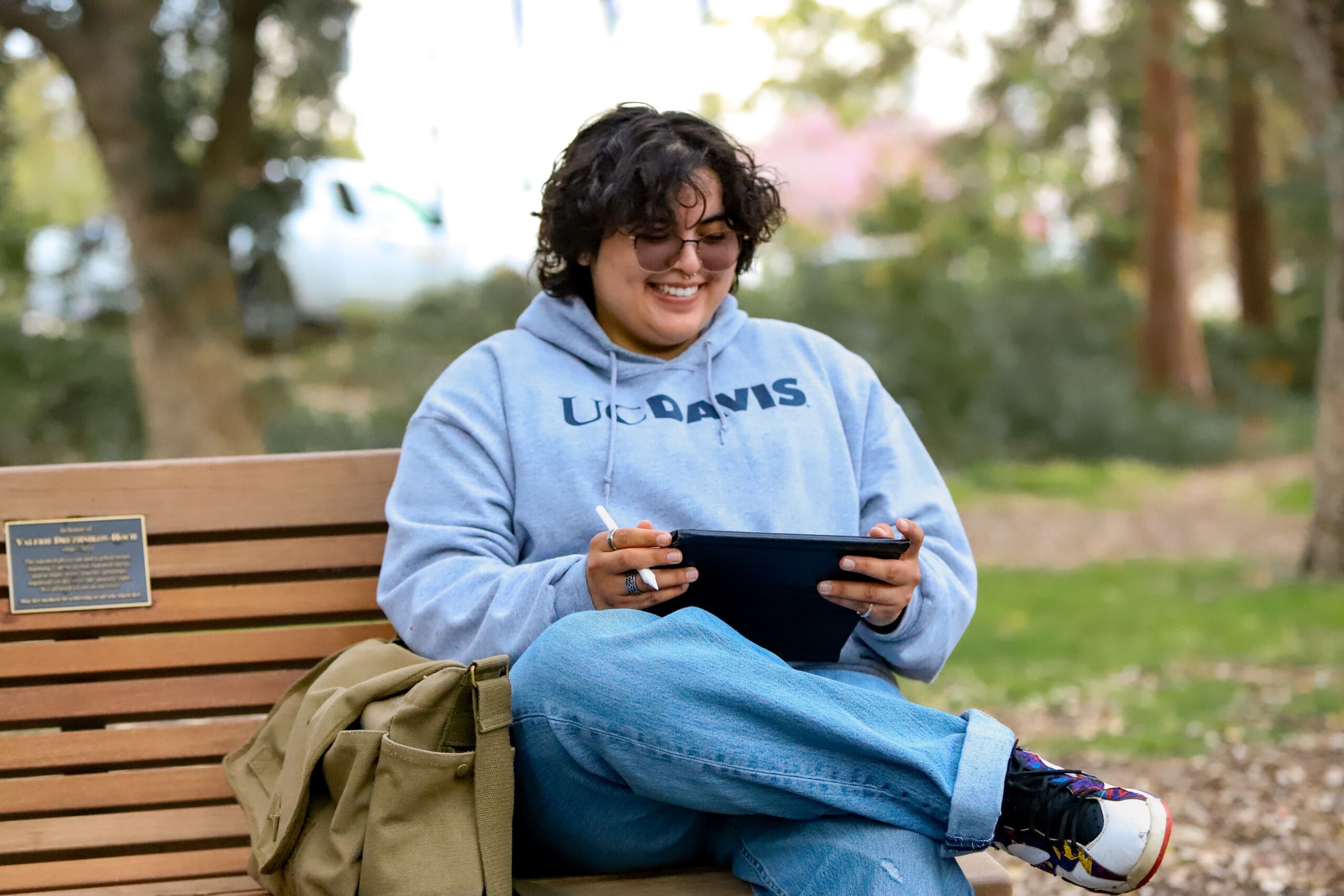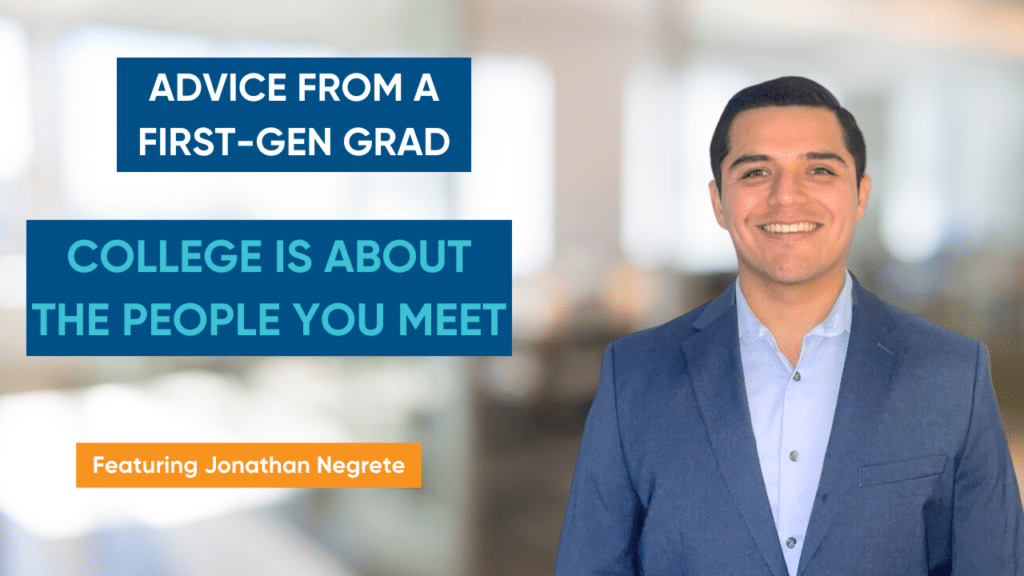
Checklists: Getting Ready for College
It’s never too early to start thinking about your plans after high school. A big part of that could be going to college, and though the idea might seem big and a little scary now, prepping ahead of time can make the whole process a lot easier.
Here are the steps you can take now in preparation for applying to college and finding financial aid in the future:
Skip to:
- Getting Ready for College: 9th Grade Checklist
- Getting Ready for College: 10th Grade Checklist
- Getting Ready for College: 11th Grade Checklist
9th Grade Checklist
Insights inspired by myfuture.com
September
Set a vision
Meet your school counselor and tell them about your dream life. You could share about your personal strengths and values, or even the hopes you have for you and your loved ones. If you tell them where you want to go in life, chances are, they can help you find a path to get there. If you don’t have a counselor, try talking to your teachers, administrators, or coaches.
October
Get involved
Join extracurricular activities to have fun and to learn more about your interests. Think about volunteering, joining clubs, participating in the arts, playing sports, or getting a job. Make a list of all the things you have accomplished. This will be helpful later on when you are trying to remember everything for a job application or a college application.
November
Explore careers
Think about the different careers you might like. If you’re not sure, you should start by looking up information online, then try talking to people who have jobs that sound interesting to you. Find out what kind of education you will need for your career. Most jobs with good pay will require going to college or learning some advanced skill. Revisit your dream life…which careers will provide the wages you’ll need to live the life you want?
December
Get good grades
Focus on getting good grades (aim for Cs or better). Every class you pass gets you closer to earning your high school diploma. If you fail some classes, you can retake them, but it might mean spending 5+ years in high school, rather than the usual 4 years. If you need extra help, talk to your teachers and let them know.
January
Pick interesting courses
Find out when you will be able to pick your classes for next year. See if your school offers honors, advanced, or Advanced Placement (AP) classes. Challenge yourself by enrolling in subjects that interest you. Ask your school counselor to help you choose the right classes. This is a good time to think about your dream life and the careers that might get you there. If you plan to get a job right after high school, a diploma might be enough. If you plan to go to college, CA colleges like University of California (UC) and California State University (CSU) expect you to take specific classes called the “a-g requirements.” Sometimes you aren’t enrolled in these classes unless you ask.
February
Talk about money
Whether you want to get some type of job training after high school or you want to go directly to college, you will need to start thinking about how to pay for it. Have a discussion with your parents or guardian about what they think they can afford. Research types of financial aid like scholarships, grants, and loans. If you need to borrow money for college or a certificate program, we recommend taking loans of no more than $5,000 per year…some debt can be good, but too much is not worth it.
March
Plan for summer
Put some thought into what you will do this summer. Whether you plan to go to college or start your career after high school, your experience can help you stand out. Some ideas include volunteering, participating in the arts, playing sports, getting a part-time job, enrolling in a camp, finding an internship, re-taking courses you might have failed, or taking courses at community college.
April
Think about testing
If you plan to go to college, some colleges expect you to take exams in order to get in. The SAT is one of these exams. You should plan on taking a Preliminary SAT (PSAT) in October of sophomore year. While the sophomore PSAT isn’t used for college applications, it will give you practice for the real thing. It also gets your name on mailing lists so you can get information on colleges. Look online for ways to practice for the PSAT. Even if you aren’t sure about what you will do after high school, it is important to keep this option open.
May
Get good grades
Focus on getting good grades (aim for Cs or better). Every class you pass gets you closer to earning your high school diploma. If you fail some classes, you can retake them, but it might mean spending 5+ years in high school, rather than the usual 4 years. If you need extra help, talk to your teachers and let them know.
June
Seek advice
Think about the different careers you might like. The summer is a good time to try talking to people who have jobs that sound interesting to you. Find out what kind of education you will need for your career. Most jobs with good pay will require going to college or learning some advanced skill. If you want a career that requires a certificate or a college degree, look at programs or colleges that offer the right majors for your career. You can learn more by searching online or by visiting friends or family members who have done similar paths.
10th Grade Checklist
Insights inspired by myfuture.com
September
Set a vision
Start your sophomore year by meeting with your school counselor and telling them about your dream life. It’s normal for your dreams, values, and hopes to change over time. Remember, if you tell them where you want to go in life, chances are, they can help you find a path to get there. If you don’t have a counselor, try talking to your teachers, administrators, or coaches.
Check your schedule
Make sure you are taking the classes you need to earn your high school diploma. If available, challenge yourself with honors, advanced, or AP classes. If you want to go to a California college like UC or CSU, double-check that you are taking the classes that meet the “a-g requirements.” Sometimes you aren’t enrolled in these classes unless you ask. See if you can find out your grade point average (GPA). Use your GPA to start narrowing down your personal list of colleges and scholarships.
Think about testing
If you plan to go to college, some colleges expect you to take exams in order to get in. The SAT is one of these exams. You should plan on taking a Preliminary SAT (PSAT) in October of sophomore year. See if you can take it at your school. While the sophomore PSAT isn’t used for college applications, it will give you practice for the real thing. It also gets your name on mailing lists so you can get information on colleges. Look online for ways to practice for the PSAT. Even if you aren’t sure about what you will do after high school, it is important to keep this option open.
October
Get involved
Stay involved in extracurricular activities like volunteering, joining clubs, participating in the arts, playing sports, getting a job, or having an internship. If possible, your extracurricular activities should start to reflect what you might do in your future career. Update your list of all the things you have accomplished in high school. This will be helpful later when you are trying to remember everything for a job application or college application.
November
Explore careers
Revisit your list of careers you might like to pursue. It’s normal for your career interests to change over time. What’s important is knowing your personal strengths. Make sure you know what kind of education you will need for your career. Most jobs with good pay will require going to college or learning some advanced skill. Revisit your dream life…which careers will provide the wages you’ll need to live the life you want?
December
Get good grades
Focus on getting good grades (aim for Cs or better). Every class you pass gets you closer to earning your high school diploma. If you fail some classes, you can retake them, but it might mean spending 5+ years in high school, rather than the usual 4 years. If you need extra help, talk to your teachers and let them know. If you are considering earning a college degree, your grades will be used to help colleges decide if they will accept you and how much money you will get for scholarships. To be academically competitive, you’ll need to give your best effort.
January
Pick interesting courses
Find out when you will be able to pick your classes for next year. See if your school offers honors, advanced, or Advanced Placement (AP) classes. Challenge yourself by enrolling in subjects that interest you. Ask your school counselor to help you choose the right classes. This is a good time to think about your dream life and the careers that might get you there. If you plan to get a job right after high school, a high school diploma is enough. If you plan to go to college, CA colleges like University of California (UC) and California State University (CSU) expect you to take specific classes called the “a-g requirements.” You will need a “C” or better in all the classes you use for “a-g requirements.” If you get a D or F in these classes, just re-take them for better grades to still be considered for college. Ask your school counselor to help you enroll in “a-g” classes. Sometimes you aren’t enrolled in these classes unless you ask.
February
Talk about money
Whether you want to get some type of job training after high school or you want to go directly to college, you will need to start thinking about how to pay for it. Have a discussion with your parents or guardian about what they think they can afford. Colleges offer online calculators to estimate your family’s Expected Family Contribution (EFC)…be prepared by estimating your EFC now. Continue researching types of financial aid like scholarships, grants, and loans. If you need to borrow money, we recommend taking loans of no more than $5,000 per year…some debt can be good, but too much is not worth it.
March
Plan for summer
Put some thought into what you will do this summer. Whether you plan to go to college or start your career after high school, your experience can help you stand out. Some ideas include volunteering, participating in the arts, playing sports, getting a part-time job, enrolling in a camp, finding an internship, re-taking courses you might have failed, or taking courses at community college. Challenge yourself by showcasing your leadership skills, whether in a program, a workplace, or in your home.
April
Find guest speakers
Ask your school counselor if any guest speakers will be visiting, particularly if they will be talking about careers or colleges. If so, see if you can meet with them. Plan to attend local career fairs and college fairs. If you want a career that requires a college degree, make sure that the colleges you are looking at offer the academic major you will need.
May
Get good grades
Focus on getting good grades (aim for Cs or better). Every class you pass gets you closer to earning your high school diploma. If you fail some classes, you can retake them, but it might mean spending 5+ years in high school, rather than the usual 4 years. If you need extra help, talk to your teachers and let them know. If you are considering earning a college degree, your grades will be used to help decide which colleges will accept you and how much money you will get for scholarships. To be academically competitive, you’ll need to give your best effort.
June
Seek advice
Going into junior year, you should start to have a clearer idea on the different careers you might like and the education levels they will require. The summer is a good time to try talking to people who have jobs that sound interesting to you. Most jobs with good pay will require going to college or learning some advanced skill. If you want a career that requires a certificate or a college degree, look at programs or colleges that offer the right majors for your career. You can learn more by searching online or by visiting friends or family members who have done similar paths.
11th Grade Checklist
Insights inspired by myfuture.com
September
Set a vision
Start your junior year by meeting with your school counselor and telling them about your dream life. It’s normal for your dreams, values, and hopes to change over time. Remember, if you tell them where you want to go in life, chances are, they can help you find a path to get there. If you don’t have a counselor, try talking to your teachers, administrators, or coaches.
Check your schedule
Make sure you are taking the classes you need to earn your high school diploma. If available, challenge yourself with honors, advanced, or AP classes. If you want to go to a California college like UC or CSU, double-check that you are taking the classes that meet the “a-g requirements.” Sometimes you aren’t enrolled in these classes unless you ask. See if you can find out your grade point average (GPA). Use your GPA to start narrowing down your personal list of colleges and scholarships
Think about testing
Take the PSAT in October. The PSAT is a test that helps prepare students for the SAT. Taking the PSAT in October not only gives you practice for the SAT, but it also qualifies you for the National Merit Scholarship Program. Ask your school counselor if you can take it during the school day.
October
Stay involved
Stay involved in extracurricular activities like volunteering, joining clubs, participating in the arts, playing sports, getting a job, or having an internship. If possible, your extracurricular activities should start to reflect what you might do in your future career. Update your list of all the things you have accomplished in high school. This will be helpful later when you are trying to remember everything for a job application or college application. Challenge yourself by showcasing your leadership skills, whether in a program, a workplace, or in your home. You could potentially talk about your experiences in your college application essays.
Show interest
Your research into colleges should start to focus on “demonstrated interest,” like interacting with colleges on social media, opening and reading emails, attending info sessions, visiting the school, and speaking with college representatives. Demonstrated interest can help you get admitted. By the end of junior year, you should narrow down your list to 5 to 10 colleges.
November
Explore careers
Revisit your list of careers you might like to pursue. It’s normal for your career interests to change over time. What’s important is knowing your personal strengths. Make sure you know what kind of education you will need for your career. Most jobs with good pay will require going to college or learning some advanced skill. Revisit your dream life…which careers will provide the wages you’ll need to live the life you want? Most colleges will require you to indicate your first-choice and second-choice majors. By the end of this year, make sure you have an idea of what you want to study at each of the colleges on your list. Sometimes the names of similar majors differ from campus to campus
Think about testing
Each college sets their own rules for admission exams. If your colleges expect you to take exams like SAT, ACT, or SAT Subject Tests, you should organize your testing schedule now. Most students complete these exams in spring of junior year and fall of senior year. Find out what your colleges require and mark the test dates and registration deadlines on your calendar. These exams cost money, but find out if you are eligible for fee waivers.
December
Get good grades
Focus on getting good grades (aim for Cs or better). Every class you pass gets you closer to earning your high school diploma. If you fail some classes, you can retake them, but it might mean spending 5+ years in high school, rather than the usual 4 years. If you need extra help, talk to your teachers and let them know. Your grades will be used to help colleges decide if they will accept you and how much money you will get for scholarships. To be academically competitive, you’ll need to give your best effort.
Visit colleges
Visit local colleges. This way you can learn more about the different options, and what you might like or not like. Even if you do not want to go to a certain school, it can still be helpful to visit and see what it is about. This way you can compare it to other schools and get a better idea of what you are looking for in a college. By the end of junior year, you should narrow down your list to 5 to 10 colleges that offer your first-choice and second-choice majors. If you can’t visit in person, look for virtual tours and college forums online.
January
Pick interesting courses
Find out when you will be able to pick your classes for next year. See if your school offers honors, advanced, or Advanced Placement (AP) classes. Challenge yourself by enrolling in subjects that interest you. Ask your school counselor to help you choose the right classes. This is a good time to think about your dream life and the careers that might get you there. If you plan to go to college, CA colleges like University of California (UC) and California State University (CSU) expect you to take specific classes called the “a-g requirements.” You will need a “C” or better in all the classes you use for “a-g requirements.” If you get a D or F in these classes, just re-take them for better grades to still be considered for college. Ask your school counselor to help you enroll in “a-g” classes. Sometimes you aren’t enrolled in these classes unless you ask.
Talk about money
If you want to go to college, you will need to think about how to pay for it. Look for an online calculator to estimate your family’s Expected Family Contribution (EFC). Research types of financial aid like scholarships, grants, and loans to learn about different ways to pay for college. If you need to borrow money for college, we recommend taking loans of no more than $5,000 per year.
February
Take practice tests
If you want to improve your chances of getting a good score on the SAT or ACT, take a practice test and use a prep book. This will help you get used to taking the test and identify areas where you need to improve. Not all colleges expect the SAT or ACT for admission. Look at each of your colleges to see what they require.
Find scholarships
There are many scholarships that students can apply for. It is important to start looking early. Talk to your school counselor and search online to find scholarships that you might be able to get. The sooner you start looking, the better prepared you will be when it is time to apply for financial aid.
March
Plan for summer
Put some thought into what you will do this summer. Whether you plan to go to college or start your career after high school, your experience can help you stand out. Some ideas include volunteering, participating in the arts, playing sports, getting a part-time job, enrolling in a camp, finding an internship, re-taking courses you might have failed, or taking courses at community college. Challenge yourself by showcasing your leadership skills, whether in a program, a workplace, or in your home. If you plan to take or retake the SAT or ACT in the fall, use the summer to prepare. Each college sets their own rules for admission exams. If your colleges expect you to take exams like SAT, ACT, or SAT Subject Tests, you should organize your testing schedule now. Find out what your colleges require and mark the test dates and registration deadlines on your calendar. These exams cost money, but find out if you are eligible for fee waivers.
April
Request recommendations
Now is the time to ask people to write you letters of recommendation. Some schools or scholarships will need these letters when you apply in the fall. Look at each of your colleges to see what they require. Asking now will give the people you have asked enough time to write a good letter. Don’t wait until senior year to secure your recommenders.
Visit colleges
To choose the right college, visit the campuses you are seriously considering and learn as much as you can. Go to your top five choices, if possible, and take a campus tour. Sit in on a class of a subject that interests you. Speak with teachers, students, school admissions counselors, and financial aid staff. If you can’t visit in person, look for virtual tours and college forums online. When you receive your final grades and any admission exam scores, compare them to each college’s acceptance ranges and see how you stack up. It’s OK to include schools that may be a challenge to get into, just make sure to also include schools you can get into easily.
May
Get good grades
Focus on getting good grades (aim for Cs or better). Every class you pass gets you closer to earning your high school diploma. If you fail some classes, you can retake them, but it might mean spending 5+ years in high school, rather than the usual 4 years. If you need extra help, talk to your teachers and let them know. Your grades will be used to help colleges decide if they will accept you and how much money you will get for scholarships. To be academically competitive, you’ll need to give your best effort.
June
Work on applications
You should start working on your college applications. This means previewing applications from the colleges you want to apply to and, if required, writing rough drafts of your essays. It’s important to get help from a teacher when you’re writing your essay so that it’s perfect before you submit it.
CO-AUTHORED WITH AI
Making Waves Education Foundation generated this text in part with artificial intelligence. Content has been reviewed, edited, and revised to our organization’s liking and we take ultimate responsibility for the content of this publication.
ABOUT MAKING WAVES EDUCATION FOUNDATION
At Making Waves, we are committed to educational equity. Making Waves Education Foundation is a Bay Area nonprofit that supports Making Waves Academy – a public charter school with more than 1,100 5th through 12th grade students – and leads college and career programming with more than 500 college students.
Knowing the opportunities that come with a college degree, we partner with historically underrepresented and underserved students to help make college affordable and graduation attainable. Centering the journeys of our students, our personalized approach includes college and career coaching, scholarships, and financial planning.
Our alumni network includes more than 600 college graduates, who earn their degrees and land jobs at more than twice the rate of their first-generation, low-income peers, with 84% graduating debt-free.




